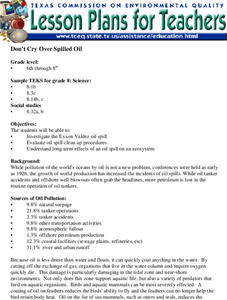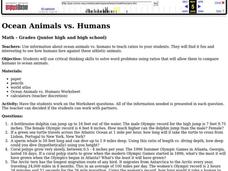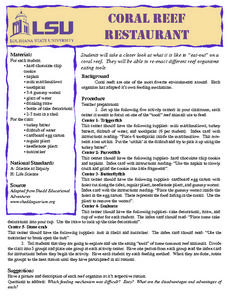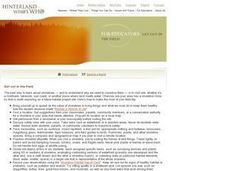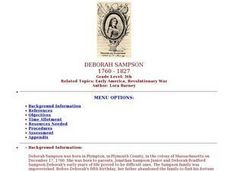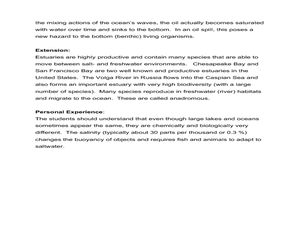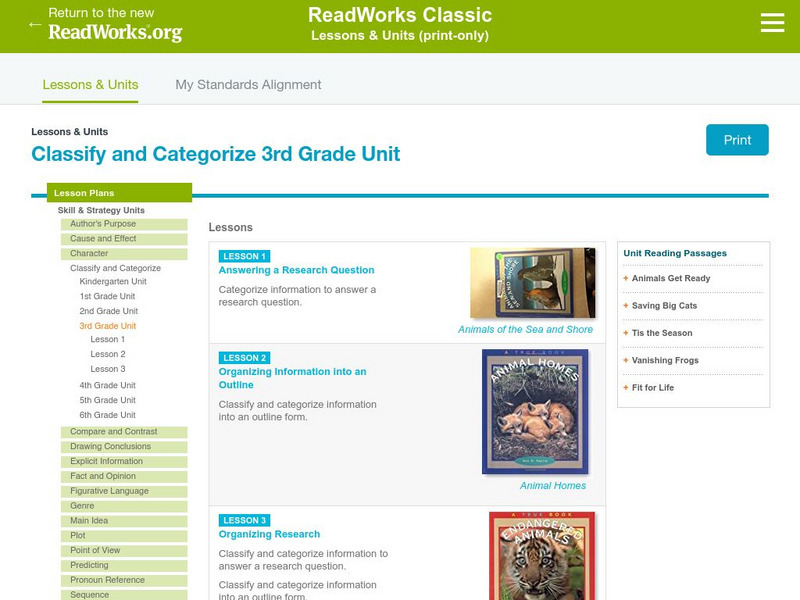Curated OER
The Importance of Groups
Young scholars discuss why groups are important and why humans go through daily life performing group activities.
Curated OER
Looking for a Walrus
Students perform the "Looking for a Walrus" song while role-playing to show their awareness of walrus adaptations. They study the words and add motions to the song.
Curated OER
Future Conditional
Students examine how toxic pollutants affect environmental and human health. They define key terms, watch a video, and answer discussion questions.
Curated OER
Alternative Alphabet
Students determine and compare hieroglyph content and frequency to an alternative alphabet based on symbols that mimic sounds of the alphabet.
Curated OER
Don't Cry Over Spilled Oil
Students study the Exxon Valdez Oil Spill while evaluating oil spill clean up activities. They discover the long term impact can have on an ecosystem by completing this experiment.
Curated OER
Ocean Animals vs. Humans
Students use critical thinking skills to solve word problems using ratios that allow them to compare humans to ocean animals.
Curated OER
Alternative Alphabet
Learners determine and compare hieroglyph content and frequency to sentences constructed in an alternative alphabet based on symbols that mimic sounds of the alphabet. They decide which images are hieroglyphs and which ones are not.
Curated OER
Warm up to the Gulf Stream
Students find out the temperature difference between the Gulf Stream and the surrounding water. They locate the Gulf Stream on the infrared image of the eastern seaboard of the US.
Curated OER
Latex Helium Balloons: Any Alternatives?
Young scholars discuss the latex balloon release controversy and review suggested alternatives to the latex balloon.
Curated OER
Word Meaning Using Prefixes
Fifth graders use structural analysis to identify root words with prefixes such as dis, sub, re, and pre.
Curated OER
Amphipod Ecology
Students count amphipods under kelp wracks of varying ages to explain how long it takes for them to find their food source. They collect and represent the data.
Curated OER
Coral Reef Restaurant
Students explore coral reefs by re-enacting different reef organisms.
Curated OER
Get Out in the Field
Pupils visit a shoreline--of an ocean, a lake, a pond, a riverbank, etc., survey it and record what they find there. They map the shoreline and surrounding area and conclude where potential waterfront projects could occur.
Curated OER
Deborah Sampson
Fifth graders describe the major accomplishments of Deborah Sampson and her importance in American history. They list in chronological order the evets that took place in Deborah Sampson's life. They demonstrae their ability to...
Curated OER
The Dead Zone: A Marine Horror Story
High schoolers graph dissolved oxygen versus depth using data taken from NECOP Program. In this marine science lesson, students explain the causes of hypoxia. They recommend possible solutions to this problem.
Curated OER
Teacher's Guide For: Water Temperature and Salinity Experiment
Students experiment with water density, temperature and salinity. For this water lesson, students observe how the coldest water sinks to the bottom of a test tube, and how saltwater sinks in comparison to freshwater.
Curated OER
All That Glitters...
Students study that white light (visible light) is comprised of all colors of the spectrum. They study that the quantity of light decreases with increasing depth in the ocean. They study that the quality of light changes with increasing...
Curated OER
John Fitch: Pioneer Steamboat Inventor
Students explore the transportation revolution brought about through the use of steam power to move boats over water. They practice note taking skills by taking notes from an article.
Curated OER
Ocean Pollution
Students study their role in eliminating ocean pollution and helping keep the oceans clean. In this environmental issues lesson, students define pollution and brainstorm examples of ocean pollution. Students define biodegradable and...
Curated OER
Bermuda: Search for Deep Water Caves 2009: Out of Darkness
High schoolers analyze the three models on the origin of troglobitic fauna. In this life science lesson, students also consider how the Zonation model explains the fauna's origin. They also use the Internet to research solutional and...
Teachers.net
Teachers.net: Who Lives in the Sea? A Class Book
A lesson plan where students work together to create an alphabet book filled with ocean plants and animals.
American Geosciences Institute
American Geosciences Institute: Earth Science Week: Sea Level and the Terrapin
Students build a model ecosystem to simulate the life and limiting factors of the Terrapin turtle.
Read Works
Read Works: Classify and Categorize 3rd Grade Unit
[Free Registration/Login Required] A three-instructional activity unit on classifying and categorizing through which students learn how to categorize information to answer research questions and then to organization that information into...
Scholastic
Scholastic: Online Theme Unit for Caves
Discover more about caves through this online interactive theme unit. This resource provides links to sea caves, cave animals, caves in the United States, the science of caves and more.
Other popular searches
- Animals Word Search
- Sea Prehistoric Animals
- African Animals Word Search
- Animals Word Search Puzzle
- Animals and the Seasons
- Seasonal Changes on Animals
- Arctic Animals Word Search
- Farm Animals Word Search
- Pond Animals Word Search
- Animals Changing Seasons
- Animals and Seasons
- Animals and Changing Seasons




